Building Muscle on Your Pit Bull: Tips & Tricks
Did you know that Pit Bulls have an innate ability to develop strong muscles? With the right approach, you can help your beloved Pit Bull build impressive muscle mass and enhance their overall strength and health. Whether you want to bulk up your Pit Bull or simply improve their muscle tone, this article will provide you with valuable tips and tricks to achieve your goals. From designing an effective exercise routine to ensuring a proper diet, I’ll guide you through the process of building muscle on your Pit Bull.
Key Takeaways:
- Building muscle is important for Pit Bulls as it improves their overall health and performance.
- A proper diet is crucial for muscle building, with a focus on high protein and essential nutrients.
- A combination of strength training exercises and cardio is necessary for effective muscle development.
- Senior Pit Bulls can also benefit from muscle-building exercises with customized routines.
- Monitoring progress, avoiding common mistakes, and staying motivated are key factors in successful muscle building.
Why Building Muscle is Important for Pit Bulls
Building muscle is essential for Pit Bulls as it offers numerous benefits and plays a crucial role in their overall well-being. By focusing on muscle building, you can significantly enhance your Pit Bull’s health and performance.
One of the key advantages of muscle building is the reduced risk of injury. Dogs with well-developed muscles are less prone to muscle strains and tears during physical activities. Additionally, strong muscles provide better support to the skeletal system, helping to safeguard against joint problems and promoting long-term joint health.
Muscle mass also contributes to increased stamina in Pit Bulls. Muscular dogs have the endurance to engage in extended physical activities, such as prolonged exercise sessions or participation in dog sports. This increased stamina allows your Pit Bull to keep up with an active lifestyle and have more energy for play, walks, and training sessions.
Another crucial benefit of muscle building is the improved recovery time from illness or injury. Dogs with substantial muscle mass tend to recuperate more quickly and efficiently when faced with health challenges. The increased blood flow to the muscles aids in the delivery of oxygen and nutrients, facilitating the healing process.
To summarize, building muscle is of paramount importance for Pit Bulls. It enhances their overall health, reduces the risk of injuries, improves stamina, and promotes swift recovery from illnesses or injuries. By incorporating muscle-building exercises and a proper diet into your Pit Bull’s routine, you can help them reach their full physical potential.
Proper Diet for Muscle Building
A proper diet is crucial for muscle building in Pit Bulls. To support muscle growth and repair, their diet should be high in protein. Additionally, essential nutrients like amino acids, creatine, carbohydrates, and healthy fats play a significant role in muscle development.
Consult with your veterinarian to determine the best diet plan for your Pit Bull’s muscle-building goals. They can assess your dog’s specific nutrient requirements and make tailored recommendations based on their age, weight, and overall health.
Incorporating a high-protein diet is essential for muscle building in Pit Bulls. Protein provides the building blocks necessary for muscle growth and repair. Include sources of lean protein such as chicken, turkey, beef, and fish in your dog’s diet. You can also incorporate high-quality commercial dog foods formulated for muscle development.
Remember:
Consulting with a veterinarian is crucial when developing a muscle-building diet for your Pit Bull. They can provide personalized guidance based on your dog’s specific needs, ensuring they receive the right balance of nutrients for optimal muscle growth and development.
In addition to protein, your Pit Bull’s diet should include other essential nutrients. Amino acids, such as arginine and leucine, aid in muscle protein synthesis. Creatine, naturally produced by the body and found in meat, can enhance muscle performance during exercise.
Carbohydrates are an important energy source for active dogs. Opt for complex carbohydrates like whole grains and vegetables to provide sustained energy throughout the day. Healthy fats, such as those from fish and plant-based oils, can also support joint health and provide additional energy.
Remember:
A balanced diet is key to supporting overall health and muscle development in Pit Bulls. Ensure your dog’s diet includes a variety of protein sources, essential nutrients, and is tailored to their specific needs.
If necessary, you can also consider incorporating supplements into your Pit Bull’s diet. Consult with your veterinarian to determine if supplements such as omega-3 fatty acids or joint support formulas would benefit your dog’s muscle-building journey.
While diet plays a crucial role in muscle building, it’s important to remember that exercise is equally important. The right combination of a proper diet and regular exercise will help your Pit Bull achieve optimal muscle growth and overall health.
| Nutrients | Sources |
|---|---|
| Protein | Chicken, turkey, beef, fish |
| Amino acids | Arginine, leucine |
| Creatine | Meat |
| Carbohydrates | Whole grains, vegetables |
| Healthy fats | Fish, plant-based oils |
Exercise Routine for Muscle Building
Regular exercise is crucial for building muscle in Pit Bulls. By incorporating a well-rounded exercise routine, you can help your dog develop strong muscles and improve their overall strength and fitness. Here are some exercises that are particularly effective for pit bull muscle building:
Strength Training Exercises
- Weight Pulling: Attach a weighted sled or cart to a harness on your pit bull’s back and encourage them to pull it. This exercise targets the muscles in their legs, shoulders, and back.
- Resistance Exercises: Use resistance bands or bodyweight exercises like push-ups, squats, and lunges to challenge your pit bull’s muscles. These exercises help build strength and improve muscle definition.
Cardio Exercises
- Running: Take your pit bull for regular runs to improve their cardiovascular endurance and burn excess body fat. Gradually increase the duration and intensity of the runs to challenge their muscles and stamina.
- Swimming: Swimming is a low-impact exercise that engages all major muscle groups. It provides an excellent cardiovascular workout while also building lean muscle mass.
When starting the exercise routine, it’s important to begin slow and gradually increase the intensity and duration of the workouts. This allows your pit bull’s muscles to adapt and prevents overexertion or injury. Always monitor your dog during exercise sessions to ensure they are not showing signs of fatigue or discomfort.
Remember, consistency is key when it comes to building muscle in your pit bull. Stick to a regular exercise schedule and be patient. Over time, with the right combination of strength training and cardio exercises, you’ll start to see improvements in your pit bull’s muscle tone, strength, and overall fitness.
Muscle Building Tips for Senior Pit Bulls
Senior Pit Bulls can also benefit from muscle-building exercises and a proper diet. As dogs age, their muscle mass naturally begins to decline, which can lead to decreased mobility and overall weakness. To counteract this, it’s important to incorporate specific exercises and a well-balanced diet into their routine.
Exercise
When it comes to muscle building for senior dogs, it’s essential to tailor the exercises to their age and physical capabilities. Low-impact exercises such as walking, swimming, and gentle agility training can help maintain muscle tone without putting excessive strain on their joints.
Here are some exercises suitable for aging Pit Bulls:
- Slow-paced walks: Regular walks stimulate muscle activity and keep your senior Pit Bull active.
- Swimming: Swimming is a great low-impact exercise that works the entire body without putting stress on the joints. Ensure proper supervision and safety precautions.
- Puzzle toys: Mental stimulation is just as important for muscle health. Use puzzle toys to keep your dog mentally engaged and active.
Diet
A well-balanced diet is crucial for senior Pit Bulls’ muscle health. Provide them with a high-quality senior dog food that supports muscle development and contains essential nutrients. Consult with your veterinarian to determine the right amount of protein, healthy fats, and carbohydrates your senior Pit Bull needs.
Tip: Consider incorporating supplements such as glucosamine and omega-3 fatty acids into their diet to support joint health and reduce inflammation.
| Key Nutrients for Muscle Health in Senior Pit Bulls | Food Sources |
|---|---|
| Protein | Lean meats, fish, poultry, eggs |
| Healthy Fats | Salmon, flaxseed oil |
| Carbohydrates | Whole grains, fruits, vegetables |
Remember to provide fresh water at all times and monitor your senior Pit Bull’s eating habits to ensure they are maintaining a healthy weight.
By implementing these muscle building tips and adopting a holistic approach, you can help your senior Pit Bull maintain muscle strength, mobility, and overall vitality. However, it’s crucial to work closely with your veterinarian to create a customized exercise routine and diet plan that caters to your senior Pit Bull’s specific needs and limitations.
Common Mistakes to Avoid
While building muscle in Pit Bulls, it’s crucial to be aware of and avoid common mistakes that can hinder their progress and pose risks to their well-being. By taking a responsible approach and understanding the pitfalls of muscle building for dogs, you can ensure that your Pit Bull’s fitness regimen is effective and safe.
Overexertion
One of the most significant mistakes dog owners make when building muscle is pushing their Pit Bulls too hard. Overtraining can lead to fatigue, muscle strain, and increased risk of injury. It’s important to gradually increase the intensity and duration of exercise and provide adequate rest time for proper recovery.
Using Unprofessional Equipment
Inappropriate or poorly designed equipment can cause harm to your Pit Bull and compromise their muscle-building efforts. Ensure that you use professional-grade equipment that is specifically designed for canine exercise. This includes harnesses, weight pulling equipment, and resistance bands that properly distribute the load and minimize the risk of injury.
Improper Nutrition
Avoiding proper nutrition is a common mistake that can impede muscle growth in Pit Bulls. Dogs need a high-protein diet to support muscle development. Consult with a veterinarian to create a balanced and tailored muscle-building diet that meets your Pit Bull’s nutritional requirements.
Insufficient Rest and Recovery Time
Rest and recovery are integral parts of the muscle-building process. Adequate rest allows the muscles to repair and grow stronger. Avoid overworking your Pit Bull and ensure they have enough downtime between exercise sessions. This will not only prevent fatigue but also help prevent muscle strains and injuries.
By understanding and avoiding these common mistakes, you can create a safe and effective pit bull fitness regimen. Always prioritize your dog’s well-being and health, and consult with a veterinarian for personalized guidance tailored to your Pit Bull’s specific needs.
Red Flags to Watch Out For
When building muscle in Pit Bulls, it’s crucial to be aware of the signs that may indicate overtraining or muscle strain. Paying attention to these red flags can help you prevent further complications and ensure the well-being of your furry companion.
Here are some signs to watch out for:
- Lameness: If you notice that your Pit Bull is limping or favoring a particular leg, it could be a sign of muscle strain or injury.
- Decreased appetite: A sudden loss of interest in food or a decreased appetite may indicate that your dog is not feeling well and may be overexerted.
- Fatigue: If your Pit Bull seems excessively tired and lacks energy during or after exercise, it could be a sign of overtraining or muscle fatigue.
- Excessive panting: While some panting during exercise is normal, excessive panting that persists even after your dog has rested could be a sign of overexertion.
- Changes in behavior: If your Pit Bull becomes unusually irritable, grumpy, or shows signs of discomfort during or after exercise, it’s essential to investigate the cause.
If you notice any of these red flags in your Pit Bull, it’s important to consult with your veterinarian. They can evaluate your dog’s condition, provide proper guidance, and help you adjust your muscle-building routine to prevent further strain or injury.
| Signs of Overtraining | Indicators of Muscle Strain |
|---|---|
| Lameness | Decreased Appetite |
| Fatigue | Excessive Panting |
| Excessive Panting | Changes in Behavior |
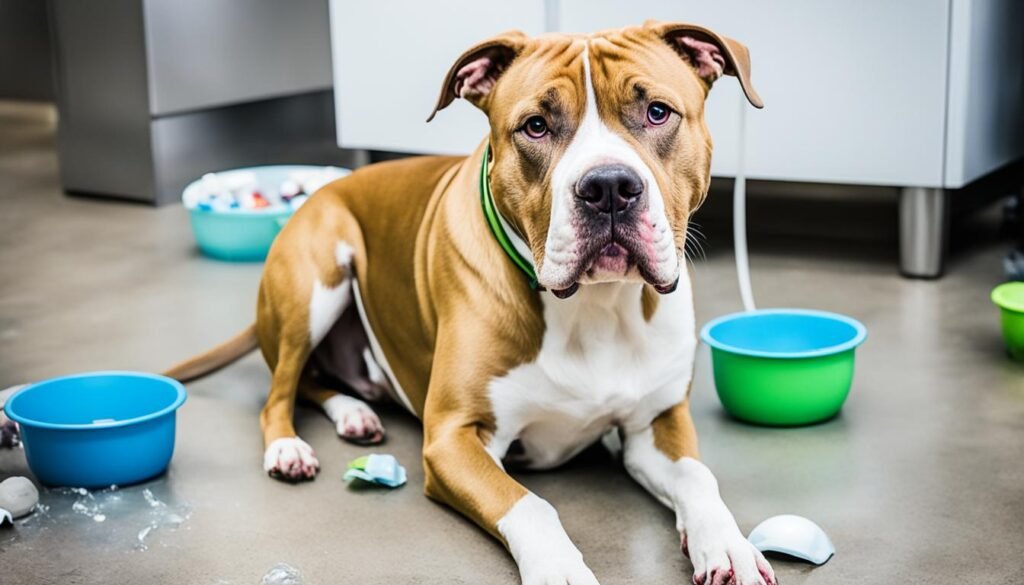
Monitoring Progress and Adjusting the Routine
As I continue to focus on building muscle in my Pit Bull, it’s crucial to regularly monitor their progress and make necessary adjustments to their exercise routine and diet. By staying attentive and observant, I can ensure that the muscle-building efforts are effective and tailored to my dog’s specific needs.
Tracking Muscle Development in Pit Bulls:
One of the key aspects of monitoring progress is assessing the muscle development in my Pit Bull. By observing their physique and muscle condition, I can gauge the effectiveness of the exercise routine and adjust it accordingly. It’s important to look for signs of muscle growth, such as increased definition and overall muscle tone.
Assessing Muscle Gains:
Additionally, I regularly assess my Pit Bull’s body weight to ensure that their muscle-building efforts are not resulting in unhealthy weight gain or loss. Maintaining a healthy weight is essential for overall health and optimal muscle development. By monitoring their body weight, I can make adjustments to their diet and exercise routine if necessary.
Modifying the Pit Bull Exercise Routine:
It’s important to remember that every dog is unique, and what works for one may not work for another. If I notice that my Pit Bull is not making the desired muscle gains or is experiencing any difficulties, I am proactive in modifying their exercise routine. This may involve incorporating new exercises, increasing or decreasing the intensity, or adjusting the frequency of workouts.
Regularly assessing my Pit Bull’s muscle development and making adjustments to their exercise routine and diet ensures that I am providing them with optimal conditions to build strong muscles.
By closely monitoring my Pit Bull’s progress and making necessary modifications to their exercise routine and diet, I can optimize their muscle-building potential. It’s important to remember that building muscle takes time and effort, so I remain patient and dedicated throughout the process.
Monitoring Progress Checklist
| Aspect | Monitoring Method |
|---|---|
| Muscle Development | Regularly assess muscle tone and definition |
| Body Weight | Monitor weight changes to maintain a healthy range |
| Exercise Routine | Modify exercises, intensity, and frequency as needed |
Tips for Consistency and Motivation
When it comes to building muscle in your Pit Bull, staying consistent and motivated is crucial for long-term success. Setting realistic goals, establishing a regular exercise routine, and providing a proper diet are key steps in achieving your desired results. However, it’s important to remember that building muscle takes time and dedication. Here are some tips to help you stay on track:
- Set realistic goals: Start with attainable goals that can be achieved over time. Break them down into smaller milestones, and celebrate each accomplishment. This will keep you motivated and inspired to continue.
- Establish a regular exercise routine: Consistency is key when it comes to building muscle. Create a schedule that includes regular exercise sessions for your Pit Bull. Make it a part of your daily routine, just like brushing your teeth or going for a walk.
- Provide a proper diet: Nutrition plays a crucial role in muscle building. Feed your Pit Bull a balanced diet that is rich in protein, essential nutrients, and healthy fats. Consult with your veterinarian to ensure their dietary needs are being met.
- Celebrate small wins: Building muscle takes time, so it’s important to celebrate even the smallest of victories. Whether it’s an increase in weight lifted or an improvement in endurance, acknowledge and reward your Pit Bull’s progress along the way.
- Seek support from fellow dog owners: Building muscle can be challenging, but you don’t have to do it alone. Connect with other dog owners who are also focused on muscle building. Share your experiences, seek advice, and motivate each other to overcome any challenges that may arise.
Remember, consistency and motivation go hand in hand when it comes to building muscle in your Pit Bull. Stay committed to your goals, stay positive, and keep pushing forward. Your hard work will pay off in the form of a strong, healthy, and happy dog.
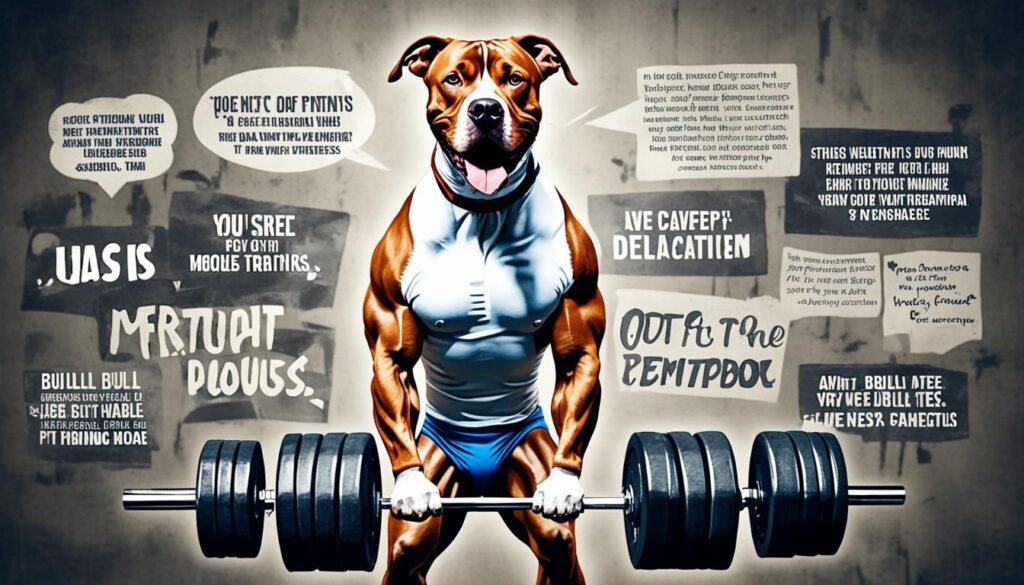
| Benefits of Consistency and Motivation | Challenges in Building Muscle |
|---|---|
| 1. Improved muscle development and strength | 1. Overexertion and risk of injury |
| 2. Enhanced overall health and well-being | 2. Lack of progress and frustration |
| 3. Increased endurance and performance | 3. Maintaining a balanced diet |
| 4. Decreased risk of joint problems | 4. Finding time for regular exercise |
Managing Weight and Body Composition
Along with muscle building, maintaining a healthy weight and body composition is crucial for Pit Bulls. A balanced diet and regular exercise routine play a vital role in achieving optimum weight and body condition.
Regular monitoring of your Pit Bull’s body condition is essential to ensure they are at a healthy weight. Use a body condition scoring system recommended by your veterinarian to assess their body composition accurately. By regularly checking their weight and body condition, you can identify any changes early on and make adjustments to their diet and exercise routine as necessary.
“Maintaining a healthy weight is important for preventing obesity-related health issues and promoting long-term well-being in Pit Bulls.”
To manage weight effectively, consider the following:
- Provide a balanced diet that meets your Pit Bull’s nutritional needs without excess calories. Consult with your veterinarian to determine the appropriate daily caloric intake and feed them the recommended portion sizes.
- Incorporate regular exercise into your Pit Bull’s routine. Physical activity helps burn calories and maintain muscle mass. Make exercise enjoyable by engaging in activities such as brisk walks, interactive play sessions, or agility training.
- Be mindful of treats and snacks. While it’s important to reward your Pit Bull, excessive treats can contribute to weight gain. Choose healthy, low-calorie options or try using their daily kibble as rewards during training sessions.
- Watch out for excessive weight gain or loss. Sudden weight gain or loss may indicate an underlying health issue. If you notice significant changes in your Pit Bull’s weight, consult with your veterinarian to rule out any underlying medical conditions.
- Consider incorporating weight management diets or portion-controlled meals specifically formulated for weight maintenance. These diets typically have a lower calorie content and may contain added ingredients to support weight control.
Remember, maintaining a healthy weight helps support your Pit Bull’s overall health and well-being. It not only benefits their body composition and muscle development but also reduces the risk of obesity-related health issues.
By adopting a proactive approach and prioritizing weight management, you can ensure your Pit Bull leads a happy, healthy life.
Holistic Approach to Muscle Building
When it comes to building muscle in Pit Bulls, taking a holistic approach is key. It’s not just about physical exercise and a proper diet; mental stimulation, rest, and recovery are equally important. Incorporating these elements into your Pit Bull’s muscle-building routine will ensure their overall well-being and maximize their muscle gains.
Engage the Mind
Remember that mental stimulation is just as essential as physical exercise for your Pit Bull’s muscle building. Engage their mind with puzzle toys that challenge their problem-solving skills and training exercises that encourage focus and obedience. These activities not only keep them entertained but also promote mental alertness, which complements their physical development.
Rest and Recovery
Allowing your Pit Bull adequate rest and recovery is vital for muscle growth and overall health. Just like humans, dogs need time to recuperate and recharge. Ensure that your furry friend has a comfortable space to relax and unwind after intense workouts. This downtime allows their muscles to recover, reducing the risk of injury and optimizing muscle gains.
“Rest is not idleness, and to lie sometimes on the grass under trees on a summer’s day, listening to the murmur of the water, or watching the clouds float across the sky, is by no means a waste of time.” – John Lubbock
Incorporate rest days into your Pit Bull’s exercise routine. These days off from intense physical activity allow their muscles to repair and grow stronger. During this time, you can still engage their mind with low-impact mental stimulation activities like scent games or gentle training exercises. Striking the right balance between exercise and rest is crucial for long-term muscle development and overall fitness.
By taking a holistic approach to muscle building, you are ensuring that your Pit Bull’s well-being is prioritized. Physical exercise, mental stimulation, rest, and recovery all work together to optimize muscle gains and enhance their overall health. So, don’t forget to engage their mind, provide ample rest, and watch the muscle-building progress unfold!
Conclusion
Building muscle in Pit Bulls requires a combination of a proper diet, regular exercise, and consistent effort. By following a tailored muscle-building routine and monitoring your dog’s progress, you can help your Pit Bull develop strong muscles, improve their overall health, and enhance their performance. Always prioritize their well-being and consult with your veterinarian for personalized guidance.
Remember, a high-protein diet is essential for muscle growth, so be sure to provide your Pit Bull with the necessary nutrients they need. Incorporate exercises that target different muscle groups, such as weight pulling and resistance training, to promote balanced muscle development. Start with low intensity and gradually increase the intensity and duration of the workouts to prevent overexertion and injury.
Consistency and motivation are key to success. Establish a regular exercise routine and stick to it, even on days when you may feel less motivated. Celebrate small wins along the way and seek support from fellow dog owners who are also on this journey. Remember, building muscle takes time, so be patient and keep pushing forward.
Building muscle in Pit Bulls is not only about physical exercise. Mental stimulation and proper rest and recovery are equally important. Engage your Pit Bull’s mind with puzzle toys and training exercises, and ensure they have enough downtime to recover and recharge. This holistic approach will contribute to their overall well-being and help them achieve their muscle-building goals.
FAQ
Can muscle building benefit Pit Bulls?
Yes, building muscle on your Pit Bull can improve their overall health and enhance their performance. Muscular dogs are less prone to injury and have greater stamina.
Why is building muscle important for Pit Bulls?
Building muscle in Pit Bulls improves their overall health, supports their skeletal system, and reduces the risk of joint problems in the future.
What should I feed my Pit Bull to help with muscle building?
A proper diet for muscle building in Pit Bulls should be high in protein to support muscle growth and repair. Consult with your veterinarian to determine the best diet plan.
What exercises should I incorporate into my Pit Bull’s routine for muscle building?
A combination of strength training exercises, such as weight pulling and resistance exercises, and cardio exercises like running or swimming can help build muscle in Pit Bulls.
Can senior Pit Bulls also benefit from muscle-building exercises?
Yes, senior Pit Bulls can benefit from muscle-building exercises and a proper diet. However, it’s important to consider their age and any underlying health conditions. Work closely with your veterinarian to develop a tailored routine.
What are some common mistakes to avoid when building muscle in Pit Bulls?
Common mistakes include overexertion, using unprofessional equipment, improper nutrition, and not providing enough rest and recovery time. Take a responsible approach and always prioritize your dog’s well-being.
What are some red flags to watch out for during the muscle-building process?
Signs of overtraining or muscle strain include lameness, decreased appetite, fatigue, excessive panting, and changes in behavior. If you notice any of these signs, consult with your veterinarian.
How can I monitor my Pit Bull’s progress in building muscle?
Regularly assess your Pit Bull’s muscle condition, body weight, and overall health. Make adjustments to their exercise routine and diet if necessary to optimize their muscle-building potential.
What can I do to stay consistent and motivated in building muscle on my Pit Bull?
Set realistic goals, establish a regular exercise routine, and stay dedicated to providing a proper diet. Celebrate small wins and seek support from fellow dog owners to stay motivated and overcome challenges.
Is managing weight and body composition important in muscle building?
Yes, it’s important to maintain a healthy weight and body composition in Pit Bulls. Regularly monitor their body condition and adjust their diet and exercise routine accordingly.
What is a holistic approach to muscle building in Pit Bulls?
A holistic approach includes not only physical exercise and diet but also mental stimulation and proper rest and recovery. Engage your Pit Bull’s mind with puzzle toys and ensure they have enough downtime to recharge.
How can building muscle benefit my Pit Bull?
Building muscle can improve your Pit Bull’s overall health, enhance their performance, and reduce the risk of injuries. It also supports their skeletal system and reduces the risk of joint problems.

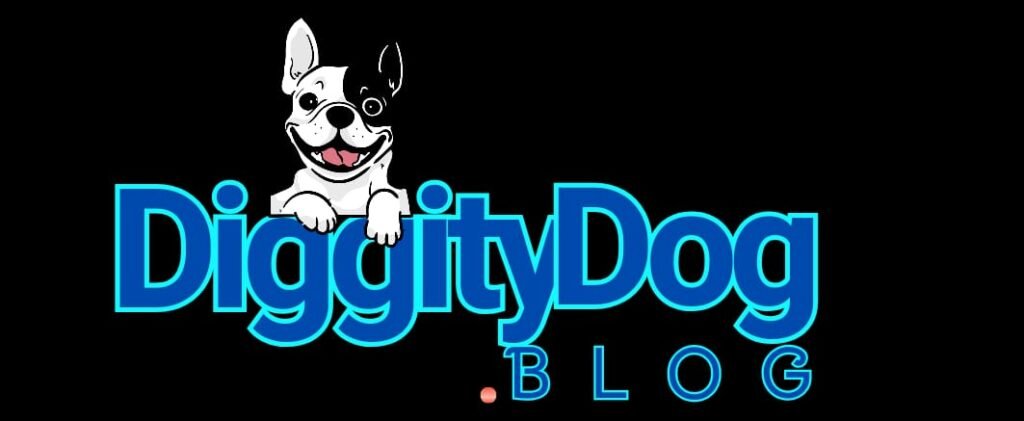

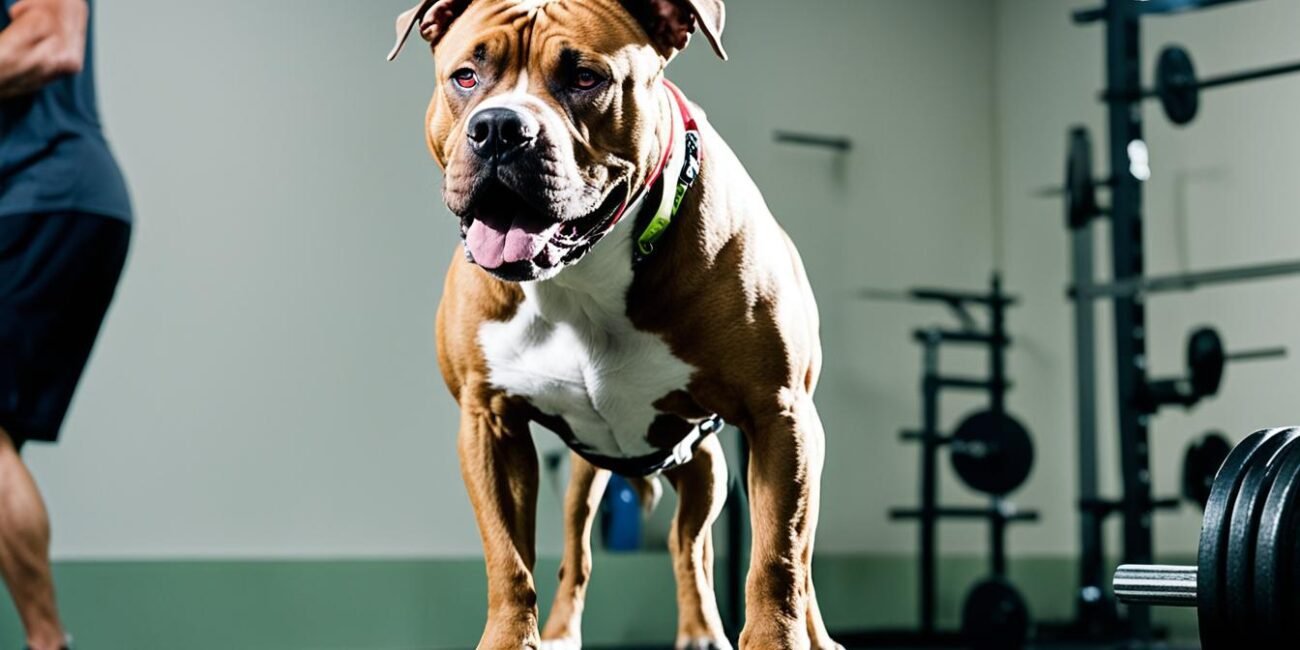





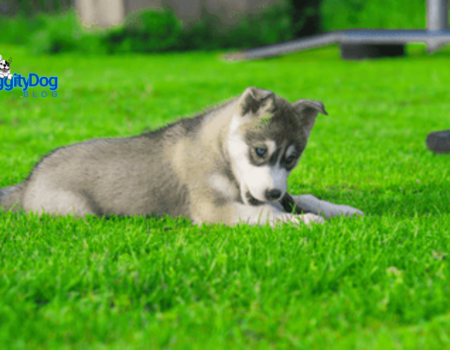
No Comment! Be the first one.